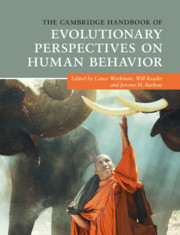Book contents
- The Cambridge Handbook of Evolutionary Perspectives on Human Behavior
- The Cambridge Handbook of Evolutionary Perspectives on Human Behavior
- Copyright page
- Dedication
- Contents
- Figures
- Tables
- Contributors
- Preface
- Acknowledgments
- Part I The Comparative Approach
- Part II Sociocultural Anthropology and Evolution
- Part III Evolution and Neuroscience
- Part IV Group Living
- 10 The Problem of Altruism and Future Directions
- 11 Can Evolutionary Processes Explain the Origins of Morality?
- 12 The Evolution and Function of Third-Party Moral Judgment
- 13 Evolution of the Human Family
- 14 The Parasite-Stress Theory of Cultural Values and Sociality
- 15 The Evolution of Pride and Shame
- 16 Thinking Outside the Head
- Part V Evolution and Cognition
- Part VI Evolution and Development
- Part VII Sexual Selection and Human Sex Differences
- Part VIII Abnormal Behavior and Evolutionary Psychopathology
- Part IX Applying Evolutionary Principles
- Part X Evolution and the Media
- Index
- References
13 - Evolution of the Human Family
from Part IV - Group Living
Published online by Cambridge University Press: 02 March 2020
- The Cambridge Handbook of Evolutionary Perspectives on Human Behavior
- The Cambridge Handbook of Evolutionary Perspectives on Human Behavior
- Copyright page
- Dedication
- Contents
- Figures
- Tables
- Contributors
- Preface
- Acknowledgments
- Part I The Comparative Approach
- Part II Sociocultural Anthropology and Evolution
- Part III Evolution and Neuroscience
- Part IV Group Living
- 10 The Problem of Altruism and Future Directions
- 11 Can Evolutionary Processes Explain the Origins of Morality?
- 12 The Evolution and Function of Third-Party Moral Judgment
- 13 Evolution of the Human Family
- 14 The Parasite-Stress Theory of Cultural Values and Sociality
- 15 The Evolution of Pride and Shame
- 16 Thinking Outside the Head
- Part V Evolution and Cognition
- Part VI Evolution and Development
- Part VII Sexual Selection and Human Sex Differences
- Part VIII Abnormal Behavior and Evolutionary Psychopathology
- Part IX Applying Evolutionary Principles
- Part X Evolution and the Media
- Index
- References
Summary
After describing common conceptions of the evolution of the human family as a unit, this chapter examines several problems with this conception and presents an alternative conception of the human family as a mechanism of tradition transmission instead of as a unit. It concludes with a discussion of some of the directions for future research generated by this reconception of the evolution of the human family.
The common conception of the family as a unit sees the evolution of the human family as a chain, in which each link in the chain is a successive form of family unit. Descriptions of this chain typically start with a hypothesized prehuman family unit that is largely based on comparisons with other primates and the fossil record, and end with the forms of family units found in the ethnographic record.
- Type
- Chapter
- Information
- Publisher: Cambridge University PressPrint publication year: 2020



